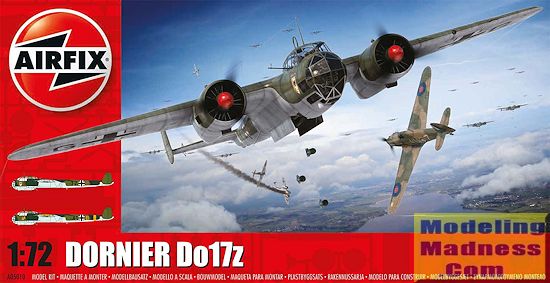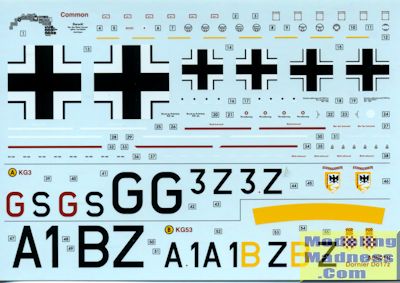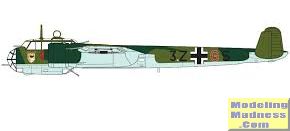
Airfix 1/72 Dornier Do-17Z
| KIT #: | A05010 |
| PRICE: | 26.99 SRP |
| DECALS: | Two options |
| REVIEWER: | Scott Van Aken |
| NOTES: | New tool kit |

| HISTORY |
The Dornier was designed with two engines mounted on a "shoulder wing" structure and possessed a twin tail fin configuration. The type was popular among its crews due to its handling, especially at low altitude, which made the Do 17 harder to hit than other German bombers.
Designed in the early 1930s, it was one of the three main Luftwaffe bomber types used in the first three years of the war. The Do 17 made its combat debut in 1937 during the Spanish Civil War, operating in the Condor Legion in various roles. Along with the Heinkel He 111 it was the main bomber type of the German air arm in 1939–1940. The Dornier was used throughout the early war, and saw action in significant numbers in every major campaign theatre as a front line aircraft until the end of 1941, when its effectiveness and usage was curtailed as its bomb load and range were limited.
The Dornier Do 17Z series was the most recognised and mass-produced variant, and saw more combat service than the E-U types. The type was modified as a result of combat experience during the Spanish Civil War. The forward fuselage was redesigned, with the cockpit area being "dropped", or extended further to enable a rear firing gunner position to be installed, and the canopy extended aft, until it was nearly parallel with the leading edge and wing root. This variant was produced in several sub-types, each subsequent version improving on the previous one.
Production of the Dornier ended in the summer of 1940, in favour of the newer and more powerful Junkers Ju 88
| THE KIT |
 This
is another highly anticipated new tool kit from Airfix, and I guess it is
natural for it to replace the Jumo powered version that previously catalogued.
Molding is up to current standards and while there are ejector pin marks on the
inside of the fuselage, inner gear doors and other large, flat areas, most will
be either covered over by parts or hidden from all but the ubiquitous IPMS
rectal laser.
This
is another highly anticipated new tool kit from Airfix, and I guess it is
natural for it to replace the Jumo powered version that previously catalogued.
Molding is up to current standards and while there are ejector pin marks on the
inside of the fuselage, inner gear doors and other large, flat areas, most will
be either covered over by parts or hidden from all but the ubiquitous IPMS
rectal laser.
With all the clear plastic in front, you'd expect a very detailed cockpit and you get one. All of the various boxes and instruments you'd see are duplicated. You get two different design pilot seats though no indication of which one to use or which marking option. There are no belts on the seat as you are expected to use the pilot figure. Next to the pilot and also just behind him are two more seats for the bombardier and the navigator. A rear facing gunner's seat is also part of the parcel with crew figures to place into them. Part of the clear upper rear facing gunner's transparency includes a bulkhead section that should be painted.
The kit included two hefty wing spars and the inner wing ribs are part of the fuselage halves as you will see these when the bomb bay is open. There is a nicely done engine nacelle assembly that consists of quite a few parts. It appears to be engineered so that later the early Do-17 could be kitted. The engine assembly includes the front cowling braces that I at first thought were pushrod assemblies until I noticed that the pushrods are molded on the engine. The kit's landing gear is very scale and I'd be surprised if the builder doesn't break the gear legs or retraction assembly when trying to remove them from the sprues; they are that thin. Of course, you can always build the plane gear up.
There are separate flaps, ailerons, elevators and rudders. The elevators can be built so they will move as apparently the idea is for the elevator hinges to not be glued onto the tail planes, but to flex back and forth as the elevators are moved. The flaps can be built deployed and there are separate inserts for the back of the nacelle to allow this to be properly done. The ailerons and rudders can also be positioned something other than neutral.
For the bomb bay, you can either take the easy way out and
use the closed piece (which also doubles as the receptacle for the optional
display stand) or go the full monty and add in bomb bay stuff. You have several load options. One is two very large bombs; one in the front and the other in
the aft bay. Another option is a long range fuel tank in the forward bay with two
side racks containing smaller bombs. Or you could have fuel tank in front, and
big  bomb in
the back. Interestingly, attaching the majority of clear bits is one of the last
steps. A final option is to have the crew entry door open.
bomb in
the back. Interestingly, attaching the majority of clear bits is one of the last
steps. A final option is to have the crew entry door open.
Instructions are typical Airfix which means they are well
drawn, have great detail diagrams and have only Humbrol paint numbers because we
can all get Humbrol paints locally. Markings are for two pla nes,
both in RLM 70/71/65. The box art plane is from 8./KG 77 based in France during
mid 1940. The other is with 15 (Kroatian)./KG 53 on the eastern front in 1941 so
has a yellow fuselage band and yellow lower wing tips. I would hope that we'd
see a spate of aftermarket markings for this one. The kit decals are fine and
without swastikas, but I know many would like something a bit different.
nes,
both in RLM 70/71/65. The box art plane is from 8./KG 77 based in France during
mid 1940. The other is with 15 (Kroatian)./KG 53 on the eastern front in 1941 so
has a yellow fuselage band and yellow lower wing tips. I would hope that we'd
see a spate of aftermarket markings for this one. The kit decals are fine and
without swastikas, but I know many would like something a bit different.
| CONCLUSIONS |
When the LHS got in this kit, they were able to sell most of them in a very short time. I know a lot of modelers like this sort of kit and Airfix has certainly stepped up to bat for us with this one.
| REFERENCES |
http://en.wikipedia.org/wiki/Dornier_Do_17
February 2015 Thanks to your editor for the preview kit. If you would like your product reviewed fairly and fairly quickly, please contact the editor or see other details in the
Note to
Contributors.